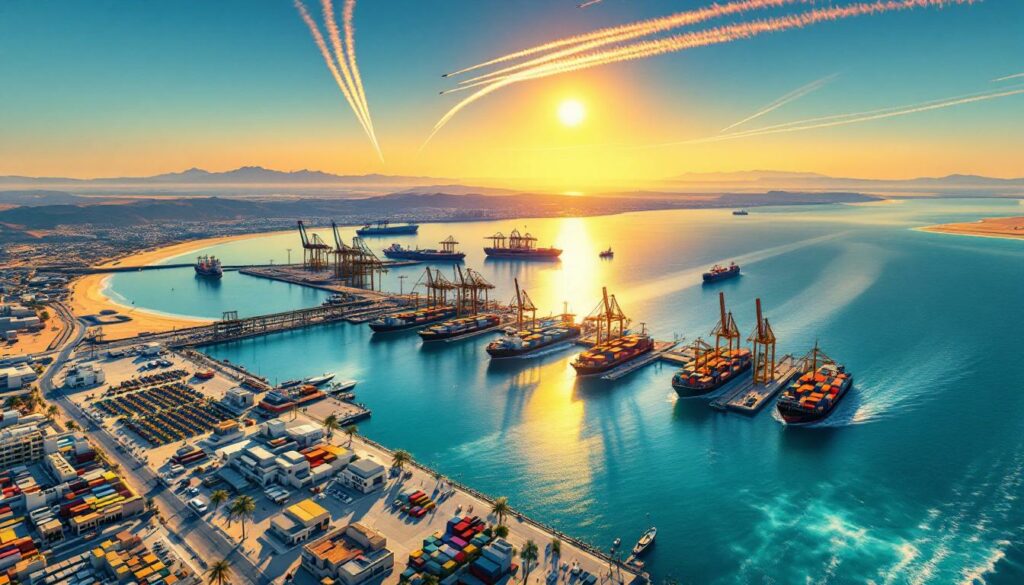Red Sea Crisis: How Houthi Attacks Have Crippled Israel's Eilat Port
The strategic southern port of Eilat, Israel's gateway to Asian and East African trade, has effectively ceased operations amid escalating Houthi militant attacks in the Red Sea region. This development marks a significant evolution in the regional maritime conflict that began in late 2023, creating substantial ripple effects across global shipping routes and Israel's economy.
According to maritime security analysts, the port closure represents one of the most tangible economic impacts of the Houthi campaign beyond Yemen's borders, affecting approximately 5-7% of Israel's total maritime trade that previously flowed through this critical southern gateway.
"The closure of Eilat Port demonstrates how asymmetric warfare tactics can achieve strategic economic impact despite the presence of international naval forces in the region," notes maritime security expert Captain Jonathan Hillman.
What Led to the Eilat Port Shutdown?
Intensified Houthi Maritime Campaign
Since October 2023, Yemen-based Houthi militants have methodically expanded their maritime operations in the Red Sea region. What began as targeted attacks on vessels with Israeli connections quickly evolved into a broader campaign affecting international shipping through this critical waterway.
By early 2024, the group had significantly expanded their operational range, deploying a combination of drone boats, anti-ship ballistic missiles, and cruise missiles against vessels up to 1,800km from Yemeni shores. This dramatic increase in capability caught many security analysts by surprise.
Maritime intelligence reports indicate the Houthis have conducted over 70 attacks on commercial vessels since November 2023, with at least 12 ships sustaining significant damage. These attacks have occurred primarily in the Bab el-Mandeb Strait and southern Red Sea, creating an effective maritime blockade of Israel's southern port.
Financial Challenges Compounding Security Concerns
While the Houthi threat represents the immediate catalyst, Eilat Port's closure stems equally from significant financial difficulties that predated the current security crisis. The port has accumulated approximately $87 million in outstanding debt to service providers, equipment suppliers, and maintenance contractors according to Israeli financial publications.
This financial instability created a situation where:
- Critical infrastructure maintenance was delayed
- Port modernization projects stalled
- Staffing levels became inadequate for safe operations
- Competitive position against neighboring ports deteriorated
The combination of security threats and financial distress created an unsustainable operational environment, effectively forcing the mid-2024 closure.
Strategic Vulnerability Exposed
Eilat's geographic location makes it uniquely vulnerable to the Houthi threat. Unlike Israel's Mediterranean ports, vessels approaching Eilat must navigate:
- The Bab el-Mandeb Strait (a narrow 29km-wide chokepoint)
- The length of the Red Sea (approximately 2,000km)
- The Gulf of Aqaba (a narrow 16km-wide inlet)
Each of these constricted waterways falls within the demonstrated range of Houthi missile and drone systems, creating what naval strategists call a "perfect interdiction zone" where vessels have limited maneuverability and defensive options.
The Lloyd's Joint War Committee designated the entire Red Sea as a "high-risk area" in December 2023, triggering automatic insurance premium increases that made commercial shipping to Eilat economically unviable regardless of actual attack frequency.
What Are the Economic Implications of the Closure?
Disruption to Regional Trade Flows
The closure of Eilat Port has forced a complete reconfiguration of Israel's Asian and East African trade networks. Prior to the shutdown, Eilat handled approximately:
- 450,000 TEU (twenty-foot equivalent units) of container traffic annually
- 1.2 million tons of bulk cargo
- 300,000 vehicles imported from Asian manufacturers
These goods must now be rerouted through Israel's Mediterranean ports of Ashdod and Haifa, creating congestion issues and requiring extensive overland transportation to reach southern destinations.
For time-sensitive goods like perishable agricultural products and high-tech components, the additional transit time represents a significant competitive disadvantage for Israeli exporters in Asian markets.
Rising Insurance and Shipping Costs
The maritime insurance market has responded dramatically to the Red Sea security situation:
| Insurance Category | Pre-Crisis Premium | Current Premium | Increase |
|---|---|---|---|
| Hull War Risk | 0.05% of vessel value | 0.5% of vessel value | 900% |
| Cargo War Risk | $0.025 per $100 value | $0.25 per $100 value | 900% |
| Kidnap & Ransom | Optional coverage | Mandatory for crews | N/A |
These increased costs have made the Red Sea route commercially unviable for many shipping companies, even with substantial military protection in place. Major carriers including Maersk, MSC, and CMA CGM implemented Red Sea surcharges ranging from $500 to $1,200 per container before eventually suspending services entirely.
Impact on Local Economy
Eilat's economy has been particularly devastated by the port closure. The facility directly employed approximately 350 workers and supported an estimated 2,000 additional jobs in related services including:
- Customs brokerage and freight forwarding
- Trucking and logistics services
- Ship provisioning and maintenance
- Administrative and security services
With tourism also significantly reduced due to the regional conflict, Eilat's unemployment rate has reportedly climbed to 18%, creating serious economic hardship in Israel's southernmost city.
"The double blow of reduced tourism and port closure has created an unprecedented economic crisis for Eilat," stated the city's Chamber of Commerce in a recent assessment. "Without significant government intervention, we face a potential population exodus from this strategically important region."
How Does This Fit Into the Broader Regional Conflict?
Houthi Strategic Objectives
The Houthi movement has explicitly positioned their maritime campaign as an act of solidarity with Palestinians amid the Gaza conflict. Their leadership has repeatedly stated they will continue attacks until Israel ends military operations in Gaza and allows unrestricted humanitarian aid.
By targeting the Eilat port, the Houthis achieve multiple strategic objectives:
- Direct economic impact: Disrupting Israel's trade routes and increasing import/export costs
- Demonstration of capability: Proving their ability to project power far beyond Yemen's borders
- International attention: Forcing global recognition of their movement as a regional power
- Commercial pressure: Compelling shipping companies to completely avoid Israeli ports
Military analysts note the Houthis have effectively implemented a sophisticated "area denial" strategy despite their limited resources, leveraging relatively inexpensive weapons to neutralize a major maritime trade route.
Expansion of Conflict Theaters
The effective closure of the Red Sea shipping lane represents a significant expansion of the conflict beyond Gaza, creating what Israeli defense officials describe as a "multi-front challenge." With tensions also high on the northern border with Lebanon, the southern maritime threat has stretched Israeli defense resources thin.
This expansion aligns with what Iranian military doctrine refers to as a "forward defense" strategy, where regional allies apply pressure across multiple fronts to prevent concentration of opposing military resources.
The Israeli Defense Forces (IDF) now face the complex challenge of:
- Maintaining naval patrols in the Red Sea
- Defending against potential maritime attacks
- Protecting Mediterranean shipping routes
- Addressing threats from other regional fronts
This multi-dimensional security environment has significantly complicated Israel's strategic calculus.
International Response Dynamics
Major naval powers including the United States, United Kingdom, and France deployed warships to the region under Operation Prosperity Guardian in December 2023. This multinational effort aimed to protect commercial shipping through the Red Sea corridor.
Despite deploying sophisticated naval assets including:
- Aircraft carriers with fighter squadrons
- Guided missile destroyers with Aegis combat systems
- Maritime patrol aircraft and surveillance drones
These forces have struggled to effectively counter the Houthi threat due to several factors:
- The vast geographic area requiring protection
- The relatively small size and difficulty detecting Houthi attack craft
- Rules of engagement limiting preemptive strikes against launch sites
- Reluctance to escalate into direct conflict with Houthi land forces
These limitations highlight the challenges conventional naval forces face when confronting asymmetric maritime threats.
What Are the Potential Solutions to Reopen the Port?
Military and Security Options
Israel faces difficult choices regarding how to address the Houthi threat. Military planners have considered several approaches, each with significant drawbacks:
- Direct strikes on Houthi positions: Could prompt wider regional escalation and Iranian involvement
- Enhanced naval escorts: Resource-intensive and still vulnerable to saturation attacks
- Maritime defense systems: Expensive to deploy and maintain across shipping lanes
- Cyber operations: Potentially effective against command systems but difficult to sustain
The Israeli military establishment appears divided on the optimal approach, with some advocating direct action while others favor continued reliance on international protection forces.
Financial Restructuring Requirements
Addressing Eilat Port's financial difficulties requires a comprehensive approach that likely includes:
- Government debt guarantees: Allowing continued operations while restructuring occurs
- Operational efficiency improvements: Modernizing cargo handling to reduce costs
- Public-private partnership models: Bringing in experienced international port operators
- Targeted infrastructure investment: Focusing on critical maintenance and security upgrades
The Israeli Ministry of Finance has reportedly begun discussions on a $120 million recovery package for the port, though implementation remains contingent on security improvements.
Diplomatic Pathways
Sustainable reopening likely requires diplomatic engagement involving regional powers and international organizations. Potential diplomatic solutions include:
- Red Sea safety corridor agreements: Internationally guaranteed shipping lanes with defined protection protocols
- Regional de-escalation negotiations: Broader discussions including the Gaza situation
- Economic incentives: Trade arrangements benefiting Yemen's legitimate government
- International maritime security cooperation: Expanded naval coalition with Arab state participation
These diplomatic efforts face significant challenges given the complex regional dynamics and multiple conflicting interests involved.
How Does This Impact Global Supply Chains?
Rerouting and Logistical Adjustments
The closure of the Red Sea route has forced global shipping companies to implement significant operational changes. Most major carriers now route vessels around Africa's Cape of Good Hope rather than through the Suez Canal, adding approximately 5,500 kilometers (3,400 miles) to the journey between Asia and Europe.
This rerouting creates multiple cascading effects:
- Extended transit times: 10-14 additional days per voyage
- Reduced effective fleet capacity: Same number of ships can complete fewer voyages annually
- Increased fuel consumption: 25-30% more fuel required per voyage
- Higher carbon emissions: Estimated 20 million additional tons of CO2 annually
For time-sensitive supply chains, these delays have required complete restructuring of inventory management and production planning systems.
Commodity Price Implications
The disruption has affected various commodity markets differently, with commodity market volatility becoming a significant concern for traders:
| Commodity Category | Price Impact | Contributing Factors |
|---|---|---|
| Oil & Gas | Limited (+2-5%) | Strategic reserves, alternative routes |
| Manufactured Goods | Moderate (+8-15%) | Increased shipping costs, delays |
| Perishable Goods | Significant (+15-25%) | Time sensitivity, refrigeration costs |
| Industrial Components | Variable | Depends on inventory levels, alternatives |
European markets dependent on Asian imports have experienced the most significant price pressures, with consumer electronics, apparel, and automotive parts seeing the largest increases. The oil price trade impacts have been relatively contained thus far, largely due to strategic reserves and diversified supply routes.
Long-term Strategic Reconsiderations
The extended nature of the crisis is prompting fundamental reconsideration of global supply chain designs. Business analysts report three emerging trends:
- Nearshoring acceleration: Moving production closer to end markets
- Inventory strategy shifts: From just-in-time to just-in-case models
- Supplier diversification: Reducing geographic concentration of vendors
For Israel specifically, the crisis has accelerated investment in northern Mediterranean ports and land-based trade corridors through Turkey and Europe, potentially creating permanent shifts in trade patterns even if Eilat eventually reopens. The tariff impact on markets has further complicated international trade, as countries implement protective measures in response to supply chain disruptions.
What's Next for the Eilat Port and Regional Security?
Scenarios for Reopening
Security and economic analysts have identified four primary scenarios that could lead to Eilat's reopening:
- Comprehensive ceasefire agreement in Gaza that includes Houthi de-escalation (considered unlikely in the near term)
- Enhanced military deterrence through coordinated international operations that effectively neutralize maritime threats (technically feasible but politically complex)
- Financial restructuring combined with international security guarantees (most likely medium-term solution)
- Alternative secure shipping arrangements through neighboring countries like Jordan or Egypt (being actively explored)
The most probable outcome involves elements of the third and fourth scenarios, with Israel developing alternative trade corridors while maintaining Eilat as a strategic asset for future reopening.
Adaptation Strategies
In response to the extended closure, Israel has implemented several adaptation strategies:
- Mediterranean port expansion: Fast-tracking development at Ashdod and Haifa
- Jordan Valley trade corridor: Enhancing road and rail connections to Jordan's Aqaba Port
- Egyptian partnerships: Negotiating transshipment arrangements through El-Arish
- Air freight capacity expansion: Increasing Ben Gurion Airport's cargo handling facilities
These measures aim to mitigate the immediate economic impact while positioning Israel's trade infrastructure for long-term resilience against regional disruptions. Furthermore, ongoing US–China trade tensions have complicated international cooperation efforts to address the Red Sea security crisis.
Monitoring Key Indicators
Several indicators will signal progress toward potential resolution:
- Diplomatic engagement: Direct or indirect talks between key stakeholders
- Insurance market signals: Reduction in Red Sea war-risk premiums
- Military operations: Changes in Houthi maritime attack capability
- Financial commitments: New investment in port infrastructure and security
Regional security experts suggest the situation will likely persist through 2024, with any resolution dependent on broader regional peace initiatives. Additionally, the US tariffs and inflation situation could impact international trade patterns as global economic tensions remain elevated.
"The Eilat Port crisis demonstrates how rapidly maritime trade patterns can shift when security and economic factors align," notes maritime economist Dr. Sarah Levinson. "Even after security conditions improve, the commercial shipping industry may be slow to return given the substantial investments already made in alternative routes."
FAQ: Eilat Port Closure and Houthi Attacks
How long has the Eilat Port been closed?
The port has faced severe operational disruptions since Houthi attacks intensified in late 2023, with formal closure procedures implemented in mid-2024 as the combined security and financial situations made continued operations untenable, according to recent reports from the Times of Israel.
What percentage of Israel's maritime trade flows through Eilat?
Prior to the closure, Eilat handled approximately 5-7% of Israel's total maritime trade volume, primarily focused on trade with Asia and East Africa. While smaller than Israel's Mediterranean ports, it represented a strategically important trade gateway.
Are other regional ports experiencing similar threats?
While other Red Sea ports face increased security concerns, Eilat's position as an Israeli port makes it a primary target for Houthi forces explicitly opposing Israel. Neighboring ports in Jordan and Egypt have implemented enhanced security measures but continue operations with elevated insurance premiums.
What alternative routes are available for goods previously shipped through Eilat?
Israeli importers and exporters are primarily redirecting cargo through Mediterranean ports like Ashdod and Haifa, accepting longer transit times and higher costs. Some companies have established transshipment arrangements through Jordan's Aqaba Port (located adjacent to Eilat) or Egyptian Mediterranean ports.
How have global shipping companies responded to the Red Sea security situation?
Major carriers including Maersk, MSC, and CMA CGM have implemented war-risk surcharges and route diversions, with many avoiding the Red Sea entirely despite the significant additional distance and fuel costs. By mid-2024, approximately 85% of container vessels that previously used the Suez Canal route had diverted to the Cape of Good Hope, as documented by OilPrice.com's analysis.
Further Exploration
Readers interested in learning more about the impact of Houthi attacks on regional shipping can explore related educational content from maritime security organizations and energy market analysts, which offer detailed analysis on how geopolitical developments affect energy markets and maritime trade patterns.
Understanding the intersection of regional security dynamics and global trade routes provides valuable context for evaluating both the immediate crisis and potential long-term shifts in international commerce.
Ready to Stay Ahead of Major Mineral Discoveries?
Discover how significant ASX mineral discoveries can generate substantial returns by exploring Discovery Alert's dedicated discoveries page, powered by their proprietary Discovery IQ model that transforms complex mineral data into actionable insights. Begin your 30-day free trial today at https://discoveryalert.com.au/discoveries/ to position yourself ahead of the market.




